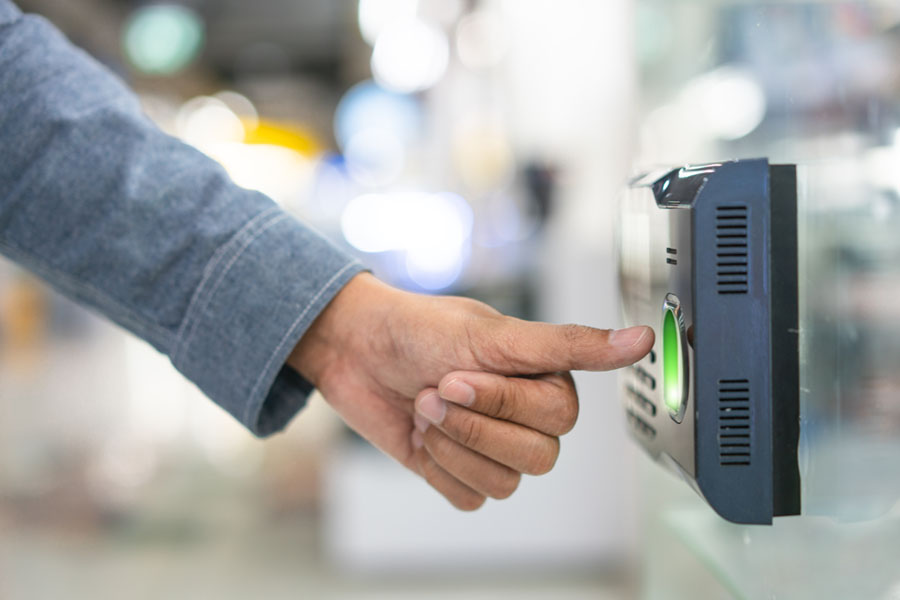
Biometric Access Control Makes Life Easier Without Keys and Cards for Access
Biometric Access Control Allows ‘Big Brother’ to Watch you Wherever you go!
Biometric access control has been in existence for less than 30 years providing various approaches to security and access control, from fingerprinting, facial recognition, retinal identifiers, and even electrical discharge for an individual.
The initial major thrust into security systems was with fingerprint identification and fingerprinting goes back to ancient times; fingerprints were used on clay tablets and clay seals for business transactions in ancient Babylon and China.
From paper card systems of fingerprint records, compared manually, through the power of the computer to electronic matching and surveillance systems of today.
The fingerprint identification systems were not infallible, and the failure rate quite high, even after many of years of research and development, such that alternatives were strived for and developed including speech, hand, face, eye (iris), and most recently the implantable intelligent chip.
VeriChip is the first FDA-approved human-implantable microchip, and when scanned it will respond with a unique 16 digit number, which can then be linked with information held in a database somewhere with this person’s details.
The advantages of this microchip over other biometrics including fingerprint analysis is the accuracy of the identification, and with the advances in chip memory, the information can be stored in the chip.
Add to this picture the fact that each chip has a radio identification frequency, unique and identifiable, makes biometric access control possibly a very dangerous innovation.
Which Way Will it Go?
Biometric access control can appear to be an innocuous approach to a sophisticated means of ensuring security without keys or cards; you are the key!
Without the sophistication and the power of computers, none of this would be possible, considering the amount of information needed in a single transaction, from the person being identified and the database of information to match to.
There are now many companies that offer the technology of biometrics within the range of older less sophisticated systems such as card readers, keypad control and proximity sensors, mainly based on a form of fingerprint identification.
Biometric systems are being touted or marketed as alternatives as against complementary or additional levels of security, yet are as vulnerable to failure or abuse as previous systems.
Clearly, biometric systems are more intrusive into the privacy and intimate details of an individuals life, using intimate details such as DNA, fingerprints and face recognition to both control and to monitor movement.
Sociological Concerns and Dangers
As biometric access control is employed more and more, there are many considerations that realistically have to be pre-empted or obviated before we go too far forward with this rapidly advancing technology.
There are sensors and instrumentation that have major sanitary considerations and the dangers that will present to users of the system.
A good example of government misuse is the data they can collect on population groups for eugenics, global population control or other controversial agendas.
There are a number of examples of thieves cutting off a finger to use for access to steal whatever they are after.
One of the arguments for adoption of biometrics is to offer protection against identity theft and the serious economic and social problems likely to be experienced, but the compromising of the data is still too open to abuse.
So Where are We?
Biometric access control is a powerful development in technology but, as with all sophisticated systems there are issues about its use and abuse.
The storage of users personal information can be compromised, in as much as the stored information can be hacked or modified, and the live input can experience variations outside the limits of accepted variation.
Similarly a person’s biometric data can be stolen allowing somebody else access to personal information or finances, to get the cash or to misuse or misrepresent the personal data.
It is not too far fetched to say that when the personal information is possibly of use to a government agency, there is nothing stopping the same thing happening, for all sorts of even unimagined purposes.
At the very least, it must be ensured that this critical data is taken proper and secure care of, or we might have a repeat of the loss of CD-based government data on a train; irreplaceable and absolutely deadly if Big Brother says your existence depends on it!

 My First Amazing Ayahuasca Experience
My First Amazing Ayahuasca Experience  Pine Needle Tea
Pine Needle Tea  The REAL Controllers of Humanity: The Papal Bloodlines
The REAL Controllers of Humanity: The Papal Bloodlines  Is it Global Warming or Cooling?
Is it Global Warming or Cooling?  Gun Rights and Obama Examined
Gun Rights and Obama Examined